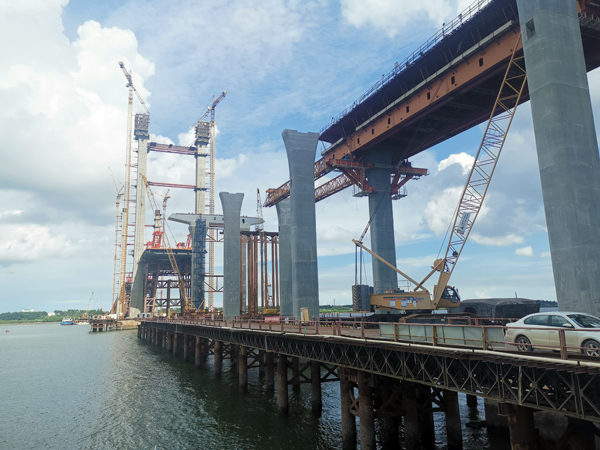Key regional transport hub bolsters capacity, expands infrastructure
A newly launched dock for handling cargo and passenger roll-on, roll-off vessels in Zhanjiang, Guangdong province, is expected to help supply the necessary transport capacity for the city to serve as a subcenter of Guangdong province.
With the operation of the new dock, located in Zhanjiang's Xuwen Port at the southern tip of China's mainland, the travel time by sea between Xuwen and the island province of Hainan is halved to about an hour, according to the local government.
Taking nearly four years to build, the dock is one of the world's largest for handling passenger and cargo roll-on, roll-off vessels with the most functions.
Xuwen Port has 16 roll-on, rolloff berths for passenger and cargo transport, and one for hazardous goods. Each of the berths is capable of accommodating vessels with a carrying capacity of up to 5,000 deadweight tons.
The designed handling capacity of the port is 3.2 million vehicles and 17.28 million passengers a year, according to the local government.
The Multimodal Transportation Complex at Xuwen Port has an area of about 77,000 square meters. Bus stations, taxi stands and car service pickup areas are available at the complex.
Space has also been reserved for connecting a high-speed rail to the port.

A cross-sea bridge is under construction in Zhanjiang. CHAI HUA/CHINA DAILY
Xuwen Port also makes travel easier for passengers by automating its services. Passengers can purchase tickets from self-service ticket machines, and scan the ticket and their faces to enter the waiting area. The whole process takes about eight minutes.
Passengers who purchase tickets online can board the ship after scanning their ID cards and faces, which is even quicker, according to local officials.
The eight boarding gates at Xuwen Port resemble those at an airport, with corridors connecting the waiting area to the ships. Passengers can board the ships almost the same way they would board an aircraft.
Zheng Renhao, Party secretary of Zhanjiang, said the city is carrying out structural reforms on the supply side of transport infrastructure, building a massive landsea corridor, expanding expressway networks, building a new international airport and upgrading harbors.
The goal, according to Zheng, is for the city to become a multimodal transport hub that is efficient and nationally and internationally connected, which will provide the necessary transport capacity for Zhanjiang to serve as a subcenter of Guangdong province and a growth pole on the province's coastal economic belt.
In terms of maritime transport, in addition to the Xuwen Port project, Zhanjiang is reconstructing and expanding the 300,000 DWT channel at Zhanjiang Port. The project involves an investment of 3.9 billion yuan ($572 million) and is due to be completed in 2022.
When completed, Zhanjiang Port will become the only world-class deep-water port in South China that can handle 400,000 DWT vessels.
On the rail transport front, Zhanjiang has become the third city in Guangdong to be included in the national master plan for railway hubs, after Guangzhou and Shenzhen.
Zhanjiang was connected to the high-speed railway network in 2018 and a new high-speed rail line connecting the city to Guangzhou is under construction.
In terms of land transport, Zhanjiang has 316 kilometers of expressway and a road density of 2.4 km per 100 square kilometers, up 37.5 percent and 36.36 percent from 2016 respectively.
In terms of air transport, Zhanjiang Airport launched 11 new routes in 2019, adding the flights to 38 domestic and international destinations. Construction of a new international airport is underway and is expected to be completed in 2021.
According to the local government, Zhanjiang will roll out plans for 46 key transportation projects this year, involving an annual investment of 15.9 billion yuan.



 Print
Print Mail
Mail

